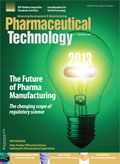A Look Ahead for 2013
From time to time, it's important to take stock of the industry from both a retrospective and prospective point of view.
Where will the future of manufacturing lead us?
From time to time, it's important to take stock of the industry from both a retrospective and prospective point of view. Throughout 2012, we celebrated 35 years of Pharmaceutical Technology, looking back at major advancements in technology, drug development and manufacturing approaches, and regulatory science. As we enter 2013, we are eager to envision what the future of bio/pharmaceutical manufacturing will bring. In this issue, in fact, a special report focuses on emerging regulatory trends, including new FDA approaches to drug reviews and inspections. You also will find a few new looks across PharmTech's pages, redesigned to address our growing industry coverage as well as to introduce you to our digital platforms.

Angie Drakulich
But getting back to science and manufacturing, we've asked our editorial advisory board members to provide their perspective on the future of bio/pharmaceutical manufacturing. Below are a few highlights.
"I believe that more companies will turn to continuous manufacturing. Continuous manufacturing allows companies to manufacture the desired dosage form in less time as well as the desired amount of drug product reducing inventory costs. Continuous manufacturing equipment can be installed in less space, thereby reducing energy and maintenance costs. QbD and PAT concepts can be incorporated within the process, reducing regulatory risks at the same time that financial benefits increase." —Rodolfo J. Romañach, Recinto Universitario de Mayaguez, Puerto Rico
"Pharmaceutical manufacturing has to become more efficient, more sustainable, 'greener' and safer for the patient. New technologies such as PAT and continuous manufacturing (with on-line quality assurance and real-time release) will help to develop products and processes according to the QbD principles and achieve these goals." —Griet Van Vaerenberg, GEA Pharma Systems
"The future of pharmaceutical manufacturing must nor resemble its past. Automation has changed the face of much of our society in the past 20 years, however the industry is somewhat paralyzed with respect to applying automation effectively in the manufacturing environment. The reasons are numerous and can be summed up in a single word: fear. Our industry fears change, 21 CFR Part 11, validation delays, inflexible operation, and more. We don't make cars, electronics, or anything else other than pharmaceuticals the way we did in 1980, so it's past time to embrace technologies that can make pharmaceutical products faster, more consistently and of substantially higher quality." —Jim Agalloco, Agalloco & Associates
"The future of pharmaceutical manufacturing lies in outsourcing. Generally, contractors manage plants at much higher utilization levels than do the multinational pharmaceutical companies, thus reducing unit cost. The divestiture of plants by merged global pharmaceutical companies to CMOs provides for significant capacity, which is viewed by multinationals as further opportunity to reduce cost. With the need to reduce costs, networking with contract manufacturers is the future." —Colin Minchom, Hovione
"Manufacturing and distribution—already regarded by regulators as 'one process'—will continue to merge their joint significance as we strive to create greater supply-chain integrity and provide the protection from falsified medicines that patients demand from manufacturers. Guidance such as that contained in USP Chapter 1083, the recent pedigree initiatives, and the new European GMP/GDP regulations will start to close the gaps that we know exist, but there is a long way to go for manufacturers and their partners." —Tony Wright, Exelsius
"The future for pharma and biotech appears to be in a state of flux. The activities covering R&D and manufacturing are no exception. The need to 'go global' is no more a concept but a reality. What comes next is finding partners who already have a global platform. One has to make a careful assessment for short-listing potential partners." —Mak Jawadekar, Consultant
"Biological medicines are a growing proportion of healthcare budgets. Increasing pressures to deliver more cost-effective therapies mean that the biotech industry needs to continuously modernize to respond effectively to future challenges. With personalized medicines on the way, innovative manufacturing strategies will be needed to bring manufacturing close to the patient. Advances in process and analytical technology are required to generate predictive small-scale mimics of processes, with data processing tools to help elucidate the interactions between multiple variables. Well-characterised processes are easier to scale up and out, allowing rapid manufacture and deployment of product." —Sharon Grimster on behalf of the BioIndustry Association Manufacturing Advisory Committee.
Angie Drakulich is editorial director of Pharmaceutical Technology.

Drug Solutions Podcast: A Closer Look at mRNA in Oncology and Vaccines
April 30th 2024In this episode fo the Drug Solutions Podcast, etherna’s vice-president of Technology and Innovation, Stefaan De Koker, discusses the merits and challenges of using mRNA as the foundation for therapeutics in oncology as well as for vaccines.
Drug Solutions Podcast: Gliding Through the Ins and Outs of the Pharma Supply Chain
November 14th 2023In this episode of the Drug Solutions podcast, Jill Murphy, former editor, speaks with Bourji Mourad, partnership director at ThermoSafe, about the supply chain in the pharmaceutical industry, specifically related to packaging, pharma air freight, and the pressure on suppliers with post-COVID-19 changes on delivery.